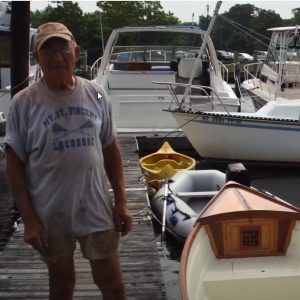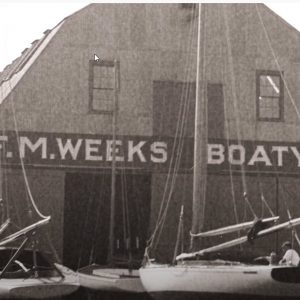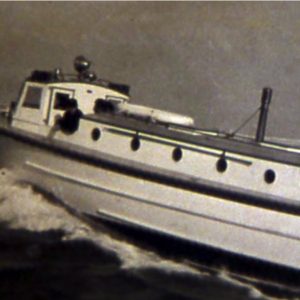Boat Building
Throughout the 19th and 20th century Long Island has been the home of many boat builders, ranging from traditional boat builders such as Gil Smith of Patchogue, who constructed garveys and skiffs for local baymen, to the Scopinich & Maresca boat yards that outfitted coast guard vessels and commercial fishing boats. Numerous industries supported this economy such as Columbia Bronze in Freeport which manufactured propellers, while Champion Sail in Freeport made custom sails for clipper ships.

Champion Sail of Freeport continues a long line of sailmakers that is carried on by the Southard Family.
Freeport
Throughout the 19th and 20th century Freeport was known for its boat building industries. The boat builders were typically immigrants from Mediterranean countries such as Italy and Greece, alongside descendants of English and Dutch settlers. Boat types constructed included trawler boats, ferry boats, Coast Guard and Navy vessels, recreational fishing craft, traditional duck boats and garveys used by baymen. The skills needed in this industry were passed down from generation to generation. By the 1880s there were numerous residents who worked either directly or indirectly on the bay and ocean as fishermen, boatmen and captains. These majestic clipper ships traveled the coast and inland waterways, transporting goods from New York and Long Island to other harbor ports. The ships depended on wind for energy, leading to a major industry in sail making in New York City. That tradition continues today under Champion Sail, located on Hudson Canal in Freeport.
By 1920 the Scopinich and Maresca families began building Coast Guard vessels during Prohibition, as well as boats built for the baymen turned rum runners. The Scopinich boatyard was founded by Fred Scopinich located at the foot of Woodcleft Canal, and was passed onto his son Fred. In 1956 “young” Fred moved the boatyard to East Quogue, where the operation remains today, under the guidance of his son Fred. Today they specialize in recreational fishing boats. The Freeport boatyard is currently used for winter storage.
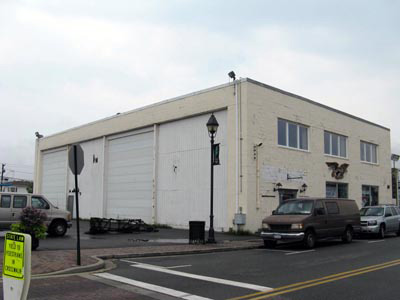
The Maresca boatyard built pleasure boats and commercial fishing boats including trawlers, closing in 1993. Founded by Phillip Maresca in the 1920s, their Freeport operations commenced after they moved an earlier boatyard from Hampton Bays. Although Phillip began his career as a printer, he turned to boat building during the Depression. His son Everett began building boats as a young teenager, eventually running the business full time. Their boatyard on Woodcleft remains, currently housing the Long Island Marine Education Center. Columbia Bronze manufactured their propellers, supplying Navy and Coast Guard boats as well.
After World War II new residents on Long Island longed for their own motorboats, leading to the creation of an enormous industry that continues today. In Freeport the Grover family began building skiffs, a shallow draft boat that could easily navigate the shallow bay waters of the estuary, yet withstand storms and ocean waves. In 1985 Al Grover broke the Guinness book of world records for the smallest outboard motor boat crossing of the Atlantic Ocean. His boat, the Trans Atlantic, can be seen at the Marine Education Center.
Throughout these historical changes men like John Remsen, his son, and Paul Ketcham have built garveys for local baymen and fishermen. The traditional garvey is a flat bottom boat so that the baymen can easily navigate the shallow bay waters in the area, in as little as 3 inches of water. The Remsens personally work with fishermen on the bay, as killey trappers and bait crab fishermen. The boats were traditionally made of oak and pine, a pattern that continues today, along with modern fiberglass to protect the boat from rotting. Ketcham refuses to use fiberglass. Other boat builders include Paul Nugent, who has restored an early 20th century skiff.
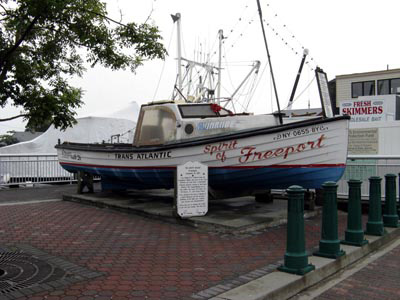
Duck Boats
Since colonial days men have hunted wildfowl on the south shore for both fun and profit. Commercial hunters also known as market gunners built specially designed watercraft that would enable them to remain hidden while providing clear shots for hunters. During the 19th and early 20th century’s commercial hunters and boat builders constructed “battery boxes,” square boxes that lay flat on the water with raised flaps to hold decoys. In the early 20th century the market gunners also used “punt” boats which held oversized shotguns, until both types of watercraft were outlawed in 1918.
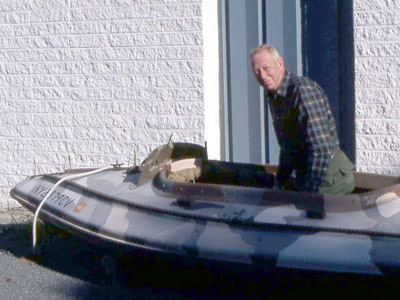
Recreational hunters used small wooden boats that could hold either one or two hunters, a tradition that has been passed down within the hunting community. The wooden fiberglass boats tend to be small, approximately 10 foot long, 2 foot high and 3 feet wide, with a hollow opening where the hunters sit. The boats are camouflaged with marsh grass or other neutral color covering, so that the hunters blend in with the surrounding landscape. The non-motorized boats are pulled by small power boats to their location, where hunters sit for several hours. They are able to go into shallow creeks with less than 2 feet of water.
During 1960 - 1990 John Magnus and Ray Milek constructed duck boats for area hunters. John learned to build the boats from his father, who started building and selling boats in the 1930s. Ray learned to build duck boats from Magnus. Both men were also active hunters and decoy carvers until the 1990s. While they continue to spend time at their bay house, both men have retired from both hunting and boat building.
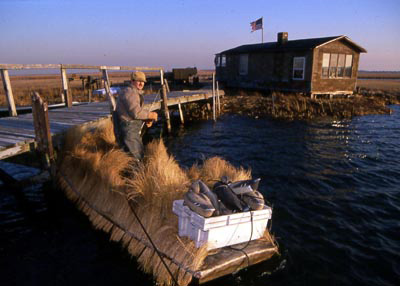
Patchogue
Patchogue has been home to major boat builders since the 1800s, making oyster catchers, clam boats, ferry boats and recreational sailing boats. Patchogue is best known for Gil Smith, who built hundreds of recreational cat boats. Gil Smith’s shop operated in the late 1800s until the mid- 1930s on the east side of Patchogue River near West Avenue and Amity Street. Smith built recreational cat boats used for sailing races. Smith’s boats were known for their sleek design and flat bottom, which was necessary for navigating the shallow waters in the shoreline areas of the bay. He also worked in various local boat yards as a machinist. Like other boat builders his business greatly expanded when the train arrived in Patchogue. Smith was also a well known bayman, hunting guide and decoy carver. Working with his wife Nancy the Smiths also sewed traditional cotton sails. He lived on Amity Street.
Other boat builders included the Weeks family, one of the first settlers in Patchogue. Frank M. Weeks was born into a family which made River Avenue in Patchogue, NY its home since the early 1700s. As a young boy Weeks was fascinated by boats and boating. After finishing school he worked full time for Martinas Smith who owned and operated a shipyard on some of the land that is today Week’s Yacht Yard. After his apprenticeship with Smith he became a master carpenter and shipwright. In 1898 he built and sold his first boat- a small cat sail boat named Onion. It is said that he paid for the building supplies for the boat by selling onions he grew behind his house.
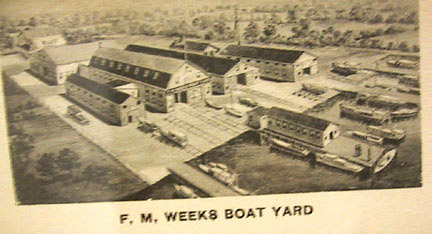
Weeks purchased land for the boat yard that currently stands on Riverview Court off River Road in small increments. By 1928 he had purchased all of the present property, approximately 5 acres. Weeks built and designed many types of boats in his lifetime. In his youth, perhaps the most famous boat he worked on was the Grace E. Bailey, a schooner built before the turn of the century which is based in Camden, Maine. He also built boats designed by John Alden and other renowned designers. As he gained experience Weeks built different lines of sailboats and powerboats. He was also known for building local designs such as the South Bay Scooters. Many of Weeks’ original tools and machinery are still used in the yard today. The Weeks property also includes a c. 1926 wood shingle house where Frank Weeks lived. The Weeks Yacht Yard is one of the oldest family run boatyards in the country.
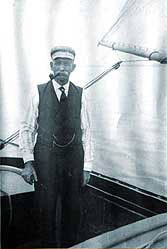
Gil Smith
There were also other boatyards in Patchogue, numbering 12 by 1892. They included those of Ellis Smith, Gilmore Baker and Martinas Smith. The Smith boatyard is currently the site of South Bay Boat Repair, located north of the Weeks Boatyard. They employed over 60 individuals including carpenters, joiners and other wood workers. The yard has been a resource for wooden boat owners and baymen, who rely on the expertise offered by longtime boat builder and restorer Charlie Balsamo.
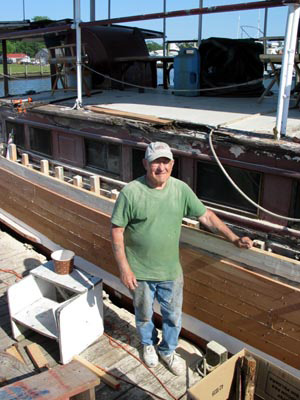
Charlie Balsamo



